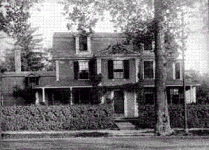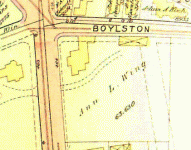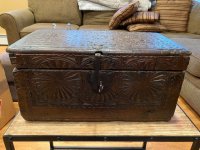Gypsy Heart
Gold Member
Capt Benjamin Hallowell Homestead
This article originally appeared in the Boston Daily Globe on December 29, 1901.
An historic old house is the old Hallowell homestead in Jamaica Plain. It is nearly 170 years old, having been built in the year 1738 by Capt Benjamin Hallowell. Here Admiral Benjamin Hallowell, one of the most noted fighters of the British navy, was born. He fought with Nelson on the Nile and at Trafalgar. And here also his brother, Ward Nicholas Boylston, was born. The latter was one of Boston and Roxbury’s most distinguished citizens, and was the man after whom Boylston St., market and school were named. Instead of calling himself Hallowell, for patriotic reasons he preferred to adopt his mother’s name of Boylston. The house stands on Center St., at the corner of Boylston.
The interesting house was erected by Benjamin Hallowell, who was staunch and true to the English cause. He was for a while known as the most unpopular, not to say most hated, man that lived in the city of Boston, or of Roxbury, and his appearance on the street during a certain period was generally the signal for a small riot, and it is related that on several occasions he barely escaped with his life.
In early life this Capt Benjamin Hallowell was the Commander of a small vessel in the British navy, and took a very prominent part in the war that ended in the conquest of Canada. His ship was a 20-gun boat called the King George, and Capt Hallowell rendered very distinguished service, notably at the occupation of Newfoundland.
After this war he moved to Boston to take up his residence, and built the old house which is now standing. He held several political positions under the King, and as the relations between England and the American provinces became more and more strained he became more and more disliked because he was looked upon as more than a direct representative of the British Crown. He finally accepted the position of Mandamus Councilor, and reached the height of his unpopularity. The resignations of various colonial officers who were in sympathy with the cause of the colonists were tendered the British government about this time, but Hallowell retained his office as Councilor, much to the disgust of every patriot.
An attack which was made upon Hallowell was virtually the cause of his leaving his homestead in Roxbury and taking up his residence within the British lines in the city proper. It seems he was passing through Cambridge Common in his chaise, accompanied by a servant on horseback, on Sept 2, 1771, the very day that the populace had assembled to accept the resignations of Danforth Lee and Olliver, other Mandamus Councilors. When the people saw him they set up a great shout, and started to pursue Hallowell’s carriage. A great mob followed him, and a squad of about 160 horsemen pressed rapidly after the unpopular man, but before they had caught him several of the wiser and cooler heads among the crowd prevailed upon them to desist from the chase and let Hallowell go in peace. A few of the more belligerent kept up the chase, however, and caught up with him just as he was passing through Roxbury.
Hallowell, to defend himself, drew a pistol and attempted to fire it, but it did not go off. He then leaped upon his servant’s horse and rode madly to the city, and fell exhausted inside the gates. From that day he kept his residence inside the town, and did not return again to his mansion, and, in fact, never passed another day under its roof as the owner of the house.
From this time until he left Boston, in March, 1776, Hallowell had very little peace, and there are on record several hand-to-hand encounters that he had to engage in upon the streets and in other public places. One in particular was with Admiral Graves in August, 1775. When the Provincial Congress met in 1775, his name was among those that it refused to pardon, and it is said that this was done in retaliation for the famous order of Gen. Gage which refused to pardon Hancock and Samuel Adams.
Hallowell left with his family for Halifax in 1776, and while there tried in vain to get a commission in the British ranks that he might engage against the colonists, but he was unsuccessful, and in July of that year went to England, where he remained until 1796. He returned to America in that year, and was very kindly received by the people that once had hated him, and spent a great deal of his time with his son, Ward Nicholas Boylston. He finally died in York (Toronto) in 1799, aged 76.
After Capt Hallowell left his home in Roxbury it was occupied for a time by a man called Jonathan Mason. It was confiscated by the State in 1791, and was sold very nearly at the time to a Frenchman named Lepirlette. When Capt Hallowell died, however, his son, Ward Nicholas Boylston acquired the home by process of law and lived there until he died in 1828.
The present owner, Dr C.E. Wing, came into possession of the property from his father, who in turn had it from the Boylston estate. The house is in an excellent state of preservation, and is exactly as it was when occupied by the original owner and builder, except for a slight addition which has been made in the rear.
The life of Admiral Benjamin Hallowell, the eldest child of the founder of the house and one of the seven Boston boys who distinguished themselves afterward in the British navy, is most interesting. He was a very dear friend of the great Nelson and fought with him in many campaigns, notably on the Nile. During these engagements he commanded a very smart ship, the Swiftsure, and it is said that his gallantry and the very fine fighting qualities of his ship were very important factors in Nelson’s achievements in Egypt. He presented the famous Admiral with the coffin that afterwards enveloped his remains.
It was rather a gruesome present for one man to make to another, but it is related that Nelson received it with good grace and much gallantry and propped it up in his cabin, where it remained for many days. The coffin was made from a mainmast of the ship Orient. Hallowell had the piece of wood picked up and made into the coffin that went to Nelson, and thus the hero of the Nile and Trafalgar had a very historical piece of wood in his bier.
Ward Nicholas Boylston, the other brother of the house, adopted his mother’s name on account, it is said of the unpopularity of his father’s name during the revolutionary period. He occupied the house until 1828, when he died. He is well known to all Bostonians, and was famous for his works of charity and for his endowments of learning. He made many valuable donations to Harvard and other institutions.
The present owner, Dr. Wing, recounts a story which he had from his father about a search for buried treasure that was made on the place. It was made during the present incumbent’s lifetime and was most mysterious in many particulars. It seems that one Sunday morning his father went into the orchard, and, while leaning on his cane under a tree, the cane suddenly slipped from his hand and went down into the earth near his feet.
He felt the sod with his toe, and found that it sank in after the cane, and then calling some workmen, they proceeded to investigate, and found that some one had removed the sod and made an excavation about three feet deep. They had done their work so neatly and carefully that not a trace of misplaced earth lay on the sward, and the sod itself had been replaced so cleverly that it defied scrutiny. The excavations were continued at the instigation of the elder Mr. Wing, but no treasure was disclosed, and it is supposed that some one had been directed there by a clairvoyant and hoped to find a fortune, presumably belonging to the old house of Hallowell. Other excavations that were made at night were subsequently found, and a close watch on the orchard never disclosed the diggers. The work has been done at intervals, although within the last eight or nine years the ground has not been disturbed.
This article originally appeared in the Boston Daily Globe on December 29, 1901.
An historic old house is the old Hallowell homestead in Jamaica Plain. It is nearly 170 years old, having been built in the year 1738 by Capt Benjamin Hallowell. Here Admiral Benjamin Hallowell, one of the most noted fighters of the British navy, was born. He fought with Nelson on the Nile and at Trafalgar. And here also his brother, Ward Nicholas Boylston, was born. The latter was one of Boston and Roxbury’s most distinguished citizens, and was the man after whom Boylston St., market and school were named. Instead of calling himself Hallowell, for patriotic reasons he preferred to adopt his mother’s name of Boylston. The house stands on Center St., at the corner of Boylston.
The interesting house was erected by Benjamin Hallowell, who was staunch and true to the English cause. He was for a while known as the most unpopular, not to say most hated, man that lived in the city of Boston, or of Roxbury, and his appearance on the street during a certain period was generally the signal for a small riot, and it is related that on several occasions he barely escaped with his life.
In early life this Capt Benjamin Hallowell was the Commander of a small vessel in the British navy, and took a very prominent part in the war that ended in the conquest of Canada. His ship was a 20-gun boat called the King George, and Capt Hallowell rendered very distinguished service, notably at the occupation of Newfoundland.
After this war he moved to Boston to take up his residence, and built the old house which is now standing. He held several political positions under the King, and as the relations between England and the American provinces became more and more strained he became more and more disliked because he was looked upon as more than a direct representative of the British Crown. He finally accepted the position of Mandamus Councilor, and reached the height of his unpopularity. The resignations of various colonial officers who were in sympathy with the cause of the colonists were tendered the British government about this time, but Hallowell retained his office as Councilor, much to the disgust of every patriot.
An attack which was made upon Hallowell was virtually the cause of his leaving his homestead in Roxbury and taking up his residence within the British lines in the city proper. It seems he was passing through Cambridge Common in his chaise, accompanied by a servant on horseback, on Sept 2, 1771, the very day that the populace had assembled to accept the resignations of Danforth Lee and Olliver, other Mandamus Councilors. When the people saw him they set up a great shout, and started to pursue Hallowell’s carriage. A great mob followed him, and a squad of about 160 horsemen pressed rapidly after the unpopular man, but before they had caught him several of the wiser and cooler heads among the crowd prevailed upon them to desist from the chase and let Hallowell go in peace. A few of the more belligerent kept up the chase, however, and caught up with him just as he was passing through Roxbury.
Hallowell, to defend himself, drew a pistol and attempted to fire it, but it did not go off. He then leaped upon his servant’s horse and rode madly to the city, and fell exhausted inside the gates. From that day he kept his residence inside the town, and did not return again to his mansion, and, in fact, never passed another day under its roof as the owner of the house.
From this time until he left Boston, in March, 1776, Hallowell had very little peace, and there are on record several hand-to-hand encounters that he had to engage in upon the streets and in other public places. One in particular was with Admiral Graves in August, 1775. When the Provincial Congress met in 1775, his name was among those that it refused to pardon, and it is said that this was done in retaliation for the famous order of Gen. Gage which refused to pardon Hancock and Samuel Adams.
Hallowell left with his family for Halifax in 1776, and while there tried in vain to get a commission in the British ranks that he might engage against the colonists, but he was unsuccessful, and in July of that year went to England, where he remained until 1796. He returned to America in that year, and was very kindly received by the people that once had hated him, and spent a great deal of his time with his son, Ward Nicholas Boylston. He finally died in York (Toronto) in 1799, aged 76.
After Capt Hallowell left his home in Roxbury it was occupied for a time by a man called Jonathan Mason. It was confiscated by the State in 1791, and was sold very nearly at the time to a Frenchman named Lepirlette. When Capt Hallowell died, however, his son, Ward Nicholas Boylston acquired the home by process of law and lived there until he died in 1828.
The present owner, Dr C.E. Wing, came into possession of the property from his father, who in turn had it from the Boylston estate. The house is in an excellent state of preservation, and is exactly as it was when occupied by the original owner and builder, except for a slight addition which has been made in the rear.
The life of Admiral Benjamin Hallowell, the eldest child of the founder of the house and one of the seven Boston boys who distinguished themselves afterward in the British navy, is most interesting. He was a very dear friend of the great Nelson and fought with him in many campaigns, notably on the Nile. During these engagements he commanded a very smart ship, the Swiftsure, and it is said that his gallantry and the very fine fighting qualities of his ship were very important factors in Nelson’s achievements in Egypt. He presented the famous Admiral with the coffin that afterwards enveloped his remains.
It was rather a gruesome present for one man to make to another, but it is related that Nelson received it with good grace and much gallantry and propped it up in his cabin, where it remained for many days. The coffin was made from a mainmast of the ship Orient. Hallowell had the piece of wood picked up and made into the coffin that went to Nelson, and thus the hero of the Nile and Trafalgar had a very historical piece of wood in his bier.
Ward Nicholas Boylston, the other brother of the house, adopted his mother’s name on account, it is said of the unpopularity of his father’s name during the revolutionary period. He occupied the house until 1828, when he died. He is well known to all Bostonians, and was famous for his works of charity and for his endowments of learning. He made many valuable donations to Harvard and other institutions.
The present owner, Dr. Wing, recounts a story which he had from his father about a search for buried treasure that was made on the place. It was made during the present incumbent’s lifetime and was most mysterious in many particulars. It seems that one Sunday morning his father went into the orchard, and, while leaning on his cane under a tree, the cane suddenly slipped from his hand and went down into the earth near his feet.
He felt the sod with his toe, and found that it sank in after the cane, and then calling some workmen, they proceeded to investigate, and found that some one had removed the sod and made an excavation about three feet deep. They had done their work so neatly and carefully that not a trace of misplaced earth lay on the sward, and the sod itself had been replaced so cleverly that it defied scrutiny. The excavations were continued at the instigation of the elder Mr. Wing, but no treasure was disclosed, and it is supposed that some one had been directed there by a clairvoyant and hoped to find a fortune, presumably belonging to the old house of Hallowell. Other excavations that were made at night were subsequently found, and a close watch on the orchard never disclosed the diggers. The work has been done at intervals, although within the last eight or nine years the ground has not been disturbed.





